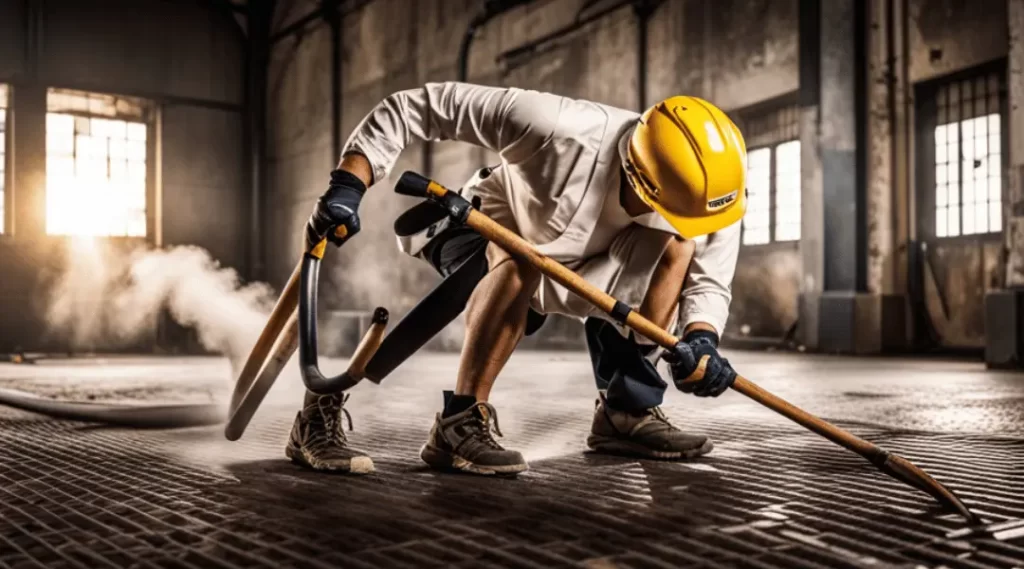Asbestos tile adhesive is a common material used in the construction industry from the 1920s until the 1980s. The adhesive was used to bond tiles to various surfaces such as floors, walls, and ceilings.
However, the use of asbestos in construction materials has been linked to serious health risks, including lung cancer, mesothelioma, and asbestosis. As a result, many homeowners and contractors are now seeking safe and effective methods for removing asbestos tile adhesive from different surfaces.
Removing asbestos tile adhesive can be a challenging and potentially hazardous task, requiring specialized equipment and expertise. However, with the proper precautions and techniques, it is possible to remove asbestos tile adhesive safely and effectively.
In this article, we will discuss the risks of asbestos exposure, the preparation needed for asbestos tile adhesive removal, and the safe methods for removing asbestos tile adhesive from different surfaces. We will also provide information on disposing of asbestos tile adhesive and hiring a professional asbestos abatement contractor.
By following these guidelines, you can ensure a safe and successful asbestos tile adhesive removal process.
Understanding the Risks of Asbestos Exposure
Exposure to asbestos poses a significant health risk, and understanding the potential dangers associated with it is crucial for ensuring safe and effective removal practices.
Asbestos is a naturally occurring mineral that was widely used in construction materials due to its durability and fire resistance.
However, when asbestos-containing materials are disturbed, they release microscopic fibers into the air that can be inhaled and cause serious health effects such as lung cancer, mesothelioma, and asbestosis.
The risk of developing these illnesses increases with the duration and intensity of exposure to asbestos fibers.
It is important to note that asbestos exposure can occur not only during the removal process. Also during transportation and disposal.
Therefore, proper precautions and protective equipment should be used to minimize the risks of exposure.
With this understanding of the risks involved, preparing for asbestos tile adhesive removal is the next crucial step.
Preparing for Asbestos Tile Adhesive Removal
This discussion focuses on the preparation necessary for asbestos tile adhesive removal. Specifically, identifying the presence of asbestos in tile adhesive, necessary precautions to take during removal, and required safety equipment.
Asbestos tile adhesive can pose a serious health risk if not handled properly. It’s important to take the necessary steps to ensure the safety of workers and occupants of the building. Proper identification of asbestos-containing materials is crucial for determining the appropriate procedures for removal and disposal.
Identifying Asbestos Tile Adhesive
The identification of the hazardous asbestos-containing material in tile adhesive is crucial due to its potential to cause severe health risks if not handled properly.
Asbestos fibers can be present in various forms and colors, including white, brown, and blue.
The only way to determine if a material contains asbestos is through laboratory testing for asbestos contamination.
It is essential to note that visual identification of asbestos is not possible. Sampling must be performed by a trained professional.
If asbestos is identified in the tile adhesive, proper precautions and safety equipment must be used to minimize the release of asbestos fibers into the air.
This includes wearing personal protective equipment, sealing off the work area, and using specialized tools and techniques during removal.
Precautions and Safety Equipment
To ensure the safety of workers and prevent the release of harmful asbestos fibers, proper precautions, and specialized safety equipment. It must be used during the removal of asbestos-containing tile adhesive.
Safety protocols should be strictly followed, and protective gear such as disposable coveralls, respirators, safety glasses, gloves should be worn. For the purpose to minimize the risk of exposure to asbestos fibers.
The work area should be isolated and sealed off with plastic sheets to prevent the spread of asbestos dust to other areas.
Any debris or waste should be carefully collected and disposed of in accordance with local regulations.
It is important to note that asbestos-containing materials should only be handled by professionals trained in safe removal practices.
With these precautions in place, workers can safely remove asbestos tile adhesive and reduce the risk of asbestos-related health problems.
Moving forward, it is important to understand the proper methods for removing asbestos tile adhesive from floors.

Removing Asbestos Tile Adhesive from Floors
When dealing with the residue left behind by asbestos tiles. The most effective approach for floors involves utilizing specialized equipment and techniques to ensure that the adhesive is removed completely. Without causing further harm to the surface. It is imp to note that different flooring options may require specific removal methods, and it is crucial to identify the type of flooring.
DIY removal of asbestos tile adhesive from floors is not recommended. As it can result in the release of harmful asbestos fibers. It’s best to seek the assistance of a professional who has the necessary tools and expertise to safely remove the adhesive. In addition to using specialized equipment, professionals also follow proper safety protocols and disposal procedures to prevent exposure to asbestos.
Asbestos tile adhesive removal from floors is a complex process that requires careful attention to detail and adherence to safety guidelines.
Transitioning into the subsequent section about removing asbestos tile adhesive from walls, it is important to note that this process also requires specialized equipment and techniques to ensure safe removal and disposal.
Removing Asbestos Tile Adhesive from Walls
Removing asbestos tile adhesive from walls requires specialized equipment and techniques to ensure the proper disposal of hazardous materials. It is crucial to follow safety protocols and regulations to avoid health risks associated with asbestos exposure.
When removing asbestos tile adhesive from walls, it is essential to have the necessary tools for efficient removal, such as a respirator, protective clothing, and a HEPA vacuum.
DIY removal of asbestos tile adhesive from walls is not recommended, as it poses a high risk of asbestos exposure and improper disposal. It is best to seek professional assistance in removing asbestos tile adhesive from walls to ensure proper disposal and avoid potential health risks.
In the next section, we will discuss the safe methods for removing asbestos tile adhesive from ceilings.
Removing Asbestos Tile Adhesive from Ceilings
The proper removal of asbestos tile adhesive from ceilings requires specialized techniques and equipment to ensure hazardous materials are disposed of safely, in accordance with industry regulations and safety protocols.
Before any adhesive removal techniques can be employed, proper ceiling preparation is necessary to minimize the risk of asbestos fibers being released into the air during the removal process. This involves sealing off the area, covering any vents or openings, and wearing protective clothing and equipment.
Tile adhesive can be difficult to remove from ceilings due to the texture and height of the surface. Common removal methods include wet scraping or sanding, which must be done carefully to avoid damaging the ceiling surface and releasing asbestos fibers.
It is important to note that DIY removal is not recommended, as it can be extremely dangerous and can even lead to legal consequences. Instead, hiring a professional asbestos removal company is highly recommended.
Proper disposal of the asbestos tile adhesive is also crucial, as it is a hazardous material that must be handled with care. In the next section, we will discuss the proper disposal methods for asbestos tile adhesive.
Disposing of Asbestos Tile Adhesive
Proper disposal of hazardous adhesive is a critical aspect of any asbestos removal process, as it ensures the safety of individuals and the environment and compliance with industry regulations.
Asbestos disposal methods are strictly regulated due to the environmental impact of asbestos disposal. It is essential to follow local regulations and guidelines for disposing of asbestos tile adhesive safely.
The most common and safe method for disposing of asbestos tile adhesive is to double-bag it in heavy-duty polyethylene bags. These bags should be labeled and transported to a licensed landfill that accepts hazardous waste.
It is highly recommended to hire a professional asbestos abatement contractor for the safe removal and disposal of asbestos tile adhesive. This ensures that the hazardous material is handled and disposed of safely and properly.
Hiring a Professional Asbestos Abatement Contractor
When it comes to asbestos abatement, it is always recommended to hire a professional contractor.
There are several benefits of hiring a qualified contractor, including ensuring the safe and proper removal of asbestos, minimizing the risk of exposure, and complying with legal regulations.
It is important to choose a contractor who is licensed, certified, and experienced in asbestos abatement to ensure the best possible outcome.
Benefits of Professional Removal
Engaging the services of professionals to handle the elimination of asbestos-containing tile adhesive comes with the added advantage of having the task carried out by experienced individuals who possess the necessary knowledge and expertise to execute the process with precision and caution.
This means that the process will be carried out in a safe and controlled manner, minimizing any potential health risks associated with asbestos exposure.
Additionally, professional removal is cost-effective in the long run as it ensures that the adhesive is completely removed, eliminating the need for any future remediation.
The peace of mind that comes with knowing that your home or workplace is asbestos-free is invaluable and cannot be achieved through DIY removal.
Furthermore, hiring a professional contractor ensures that all legal and regulatory requirements are met, avoiding any possible legal consequences that may arise from improper removal.
It is important to choose a qualified contractor who has the necessary certifications and licenses to carry out the job safely and efficiently.
Choosing a Qualified Contractor
Selecting a proficient contractor with the appropriate licenses and certifications is crucial in ensuring a successful and legally compliant removal of asbestos-containing tile adhesive.
Homeowners and business owners must be aware that not all contractors are created equal and that selecting an unqualified contractor could result in an unsafe and incomplete removal process.
The Environmental Protection Agency (EPA) requires that contractors comply with specific regulations and guidelines to ensure that they are qualified to perform asbestos abatement.
Therefore, it is essential to verify the contractor’s qualifications, which should include a current asbestos abatement license, insurance, and training certifications.
Additionally, pricing considerations are essential when selecting a contractor for asbestos tile adhesive removal.
While cost is a significant factor, it should not be the only consideration.
A reputable contractor should provide a detailed and comprehensive estimate that outlines the scope of work, materials, and labor costs.
It is crucial to avoid contractors that offer low prices or cut corners to save money.
In conclusion, choosing a qualified contractor is a crucial element that should not be overlooked when removing asbestos-containing tile adhesive.
It guarantees a safe and effective removal process that complies with all regulations.
Conclusion
Asbestos exposure is a serious health risk that everyone should be aware of when dealing with asbestos tile adhesive. It’s important to take the necessary precautions and prepare for the removal process to minimize the risk of inhaling asbestos fibers.
When removing asbestos tile adhesive, it’s crucial to follow safe methods to prevent the release of asbestos particles into the air. Removing asbestos tile adhesive from different surfaces requires different methods, such as wet stripping, dry scraping, or using chemicals.
It’s important to wear protective clothing and equipment, including a respirator, gloves, and goggles. Disposing of asbestos tile adhesive also requires proper handling and disposal methods, including labeling and transporting it to a licensed disposal site.
Removing asbestos tile adhesive is a complex and dangerous process that should only be done by professionals. Asbestos exposure can cause serious health problems, and it’s important to take all necessary precautions and follow safe methods to protect yourself and others. As they say, ‘Better safe than sorry.’ It’s better to hire a professional asbestos abatement contractor to ensure that the removal process is done safely and effectively. It’s always better to be safe than to take unnecessary risks with your health.
